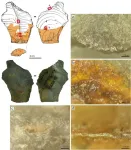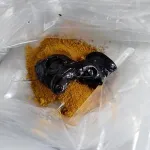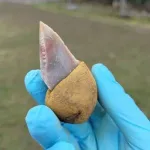(Press-News.org) Neanderthals created stone tools held together by a multi-component adhesive, a team of scientists has discovered. Its findings, which are the earliest evidence of a complex adhesive in Europe, suggest these predecessors to modern humans had a higher level of cognition and cultural development than previously thought.
The work, reported in the journal Science Advances, included researchers from New York University, the University of Tübingen, and the National Museums in Berlin.
“These astonishingly well-preserved tools showcase a technical solution broadly similar to examples of tools made by early modern humans in Africa, but the exact recipe reflects a Neanderthal ‘spin,’ which is the production of grips for handheld tools,” says Radu Iovita, an associate professor at New York University’s Center for the Study of Human Origins.
The research team, led by Patrick Schmidt from the University of Tübingen’s Early Prehistory and Quaternary Ecology section and Ewa Dutkiewicz from the Museum of Prehistory and Early History at the National Museums in Berlin, re-examined previous finds from Le Moustier, an archaeological site in France that was discovered in the early 20th century.
The stone tools from Le Moustier—used by Neanderthals during the Middle Palaeolithic period of the Mousterian between 120,000 and 40,000 years ago—are kept in the collection of Berlin’s Museum of Prehistory and Early History and had not previously been examined in detail. The tools were rediscovered during an internal review of the collection and their scientific value was recognized.
“The items had been individually wrapped and untouched since the 1960s,” says Dutkiewicz. “As a result, the adhering remains of organic substances were very well preserved.”
The researchers discovered traces of a mixture of ochre and bitumen on several stone tools, such as scrapers, flakes, and blades. Ochre is a naturally occurring earth pigment; bitumen is a component of asphalt and can be produced from crude oil, but also occurs naturally in the soil.
“We were surprised that the ochre content was more than 50 percent,” says Schmidt. “This is because air-dried bitumen can be used unaltered as an adhesive, but loses its adhesive properties when such large proportions of ochre are added.”
He and his team examined these materials in tensile tests—used to determine strength—and other measures.
“It was different when we used liquid bitumen, which is not really suitable for gluing. If 55 percent ochre is added, a malleable mass is formed,” Schmidt says.
The mixture was just sticky enough for a stone tool to remain stuck in it, but without adhering to hands, making it suitable material for a handle.
In fact, a microscopic examination of the use-wear traces on these stone tools revealed that the adhesives on the tools from Le Moustier were used in this way.
“The tools showed two kinds of microscopic wear: one is the typical polish on the sharp edges that is generally caused by working other materials,” explains Iovita, who conducted this analysis. “The other is a bright polish distributed all over the presumed hand-held part, but not elsewhere, which we interpreted as the results of abrasion from the ochre due to movement of the tool within the grip.”
The use of adhesives with several components, including various sticky substances such as tree resins and ochre, was previously known from early modern humans, Homo sapiens, in Africa but not from earlier Neanderthals in Europe. Overall, the development of adhesives and their use in the manufacture of tools is considered to be some of the best material evidence of the cultural evolution and cognitive abilities of early humans.
“Compound adhesives are considered to be among the first expressions of the modern cognitive processes that are still active today,” says Schmidt.
In the Le Moustier region, ochre and bitumen had to be collected from distant locations, which meant a great deal of effort, planning, and a targeted approach, the authors note.
“Taking into account the overall context of the finds, we assume that this adhesive material was made by Neanderthals,” concludes Dutkiewicz.
“What our study shows is that early Homo sapiens in Africa and Neanderthals in Europe had similar thought patterns,” adds Schmidt. “Their adhesive technologies have the same significance for our understanding of human evolution.”
END
Did neanderthals use glue? Researchers find evidence that sticks
Analysis of 40,000-year old tools reveals surprisingly sophisticated construction
2024-02-21
ELSE PRESS RELEASES FROM THIS DATE:
Severe maternal grief associated with increased risk of heart failure in child
2024-02-21
Prenatal stress is a potential risk factor for cardiovascular disease in offspring later in life. In a new study published today in JACC: Heart Failure, maternal loss of a partner or child shortly before or during pregnancy was found to be associated with increased risk of heart failure up to middle-age in the child.
Heart failure is a condition in which the heart cannot pump enough oxygen-rich blood to the organs, causing a variety of symptoms. Heart failure cannot be cured but symptoms can be treated and managed to improve quality and length of life. According to the World Heart Federation, more than 64 million people worldwide have heart failure.
According ...
Increasingly similar or different? Centuries-long analysis suggests biodiversity is differentiating and homogenizing to a comparable extent
2024-02-21
The tendency of communities and the species within them to become more similar or more distinct across landscapes – biotic homogenisation and differentiation – are approximately balanced, according to a new study published in Science Advances.
Led by researchers at the German Centre for Integrative Biodiversity Research (iDiv) and the Martin Luther University Halle-Wittenberg (MLU), the researchers analysed 527 datasets collected from ecosystems like grasslands, shrublands, and coral reefs as far back as 500 years ago. The analysis is the first of its kind to provide ...
Long COVID linked to persistently high levels of inflammatory protein: a potential biomarker and target for treatments
2024-02-21
SARS-CoV-2 triggers the production of the antiviral protein IFN-γ, which is associated with fatigue, muscle ache and depression. New research shows that in Long COVID patients, IFN-y production persists until symptoms improve, highlighting a potential biomarker and a target for therapies.
A University of Cambridge-led study identifies the protein interferon gamma (IFN-γ) as a potential biomarker for Long COVID fatigue and highlights an immunological mechanism underlying the disease, which could pave the way for the development ...
Snaking toward a universal antivenom
2024-02-21
LA JOLLA, CA—Scripps Research scientists have developed an antibody that can block the effects of lethal toxins in the venoms of a wide variety of snakes found throughout Africa, Asia and Australia.
The antibody, which protected mice from the normally deadly venom of snakes including black mambas and king cobras, is described on February 21, 2024, in Science Translational Medicine. The new research used forms of the toxins produced in the laboratory to screen billions of different human antibodies and identify one that can block the toxins’ activity. It represents a large step toward a universal ...
New system triggers cellular waste disposal
2024-02-21
Living cells resemble highly organized small towns - in addition to energy production, transportation systems, and construction, cells also require efficient waste disposal. Most proteins, which shape and sustain cellular function, have only a limited half-life and must eventually be disposed of, along with defective and unwanted proteins. This vital task falls upon specialized enzymes known as ubiquitin ligases, which tag obsolete proteins for degradation, guiding them to the cellular recycling center, ...
Possible trigger for autoimmune diseases discovered : B cells teach T cells which targets must not be attacked
2024-02-21
Immune cells must learn not to attack the body itself. A team of researchers from the Technical University of Munich (TUM) and the Ludwig Maximilian University of Munich (LMU) has discovered a previously unknown mechanism behind this: other immune cells, the B cells, contribute to the "training" of the T cells in the thymus gland. If this process fails, autoimmune diseases can develop. The study confirms this for Neuromyelitis optica, a disease similar to Multiple Sclerosis. Other autoimmune diseases may be linked to the failure ...
Detecting pathogens faster and more accurately by melting DNA
2024-02-21
A new analysis method can detect pathogens in blood samples faster and more accurately than blood cultures, which are the current state of the art for infection diagnosis. The new method, called digital DNA melting analysis, can produce results in under six hours, whereas culture typically requires 15 hours to several days, depending on the pathogen.
Not only is this method faster than blood cultures, it’s also significantly less likely to generate false positives compared to other emerging DNA detection-based technologies such as Next Generation Sequencing.
Why ...
MD Anderson research highlights for February 21, 2024
2024-02-21
HOUSTON ― The University of Texas MD Anderson Cancer Center’s Research Highlights showcases the latest breakthroughs in cancer care, research and prevention. These advances are made possible through seamless collaboration between MD Anderson’s world-leading clinicians and scientists, bringing discoveries from the lab to the clinic and back.
Recent developments at MD Anderson offer insights into drug-drug interactions for patients with acute myeloid leukemia (AML) and myelodysplastic syndromes; patient-derived xenograft models as a viable translational ...
Engineers use AI to wrangle fusion power for the grid
2024-02-21
In the blink of an eye, the unruly, superheated plasma that drives a fusion reaction can lose its stability and escape the strong magnetic fields confining it within the donut-shaped fusion reactor. These getaways frequently spell the end of the reaction, posing a core challenge to developing fusion as a non-polluting, virtually limitless energy source.
But a Princeton-led team composed of engineers, physicists, and data scientists from the University and the Princeton Plasma Physics Laboratory (PPPL) have harnessed ...
UChicago scientists invent ultra-thin, minimally-invasive pacemaker controlled by light
2024-02-21
Sometimes our bodies need a boost. Millions of Americans rely on pacemakers—small devices that regulate the electrical impulses of the heart in order to keep it beating smoothly. But to reduce complications, researchers would like to make these devices even smaller and less intrusive.
A team of researchers with the University of Chicago has developed a wireless device, powered by light, that can be implanted to regulate cardiovascular or neural activity in the body. The featherlight membranes, ...
LAST 30 PRESS RELEASES:
Interaction of climate change and human activity and its impact on plant diversity in Qinghai-Tibet plateau
From addressing uncertainty to national strategy: an interpretation of Professor Lim Siong Guan’s views
Clinical trials on AI language model use in digestive healthcare
Scientists improve robotic visual–inertial trajectory localization accuracy using cross-modal interaction and selection techniques
Correlation between cancer cachexia and immune-related adverse events in HCC
Human adipose tissue: a new source for functional organoids
Metro lines double as freight highways during off-peak hours, Beijing study shows
Biomedical functions and applications of nanomaterials in tumor diagnosis and treatment: perspectives from ophthalmic oncology
3D imaging unveils how passivation improves perovskite solar cell performance
Enriching framework Al sites in 8-membered rings of Cu-SSZ-39 zeolite to enhance low-temperature ammonia selective catalytic reduction performance
AI-powered RNA drug development: a new frontier in therapeutics
Decoupling the HOR enhancement on PtRu: Dynamically matching interfacial water to reaction coordinates
Sulfur isn’t poisonous when it synergistically acts with phosphine in olefins hydroformylation
URI researchers uncover molecular mechanisms behind speciation in corals
Chitin based carbon aerogel offers a cleaner way to store thermal energy
Tracing hidden sources of nitrate pollution in rapidly changing rural urban landscapes
Viruses on plastic pollution may quietly accelerate the spread of antibiotic resistance
Three UH Rainbow Babies & Children’s faculty elected to prestigious American Pediatric Society
Tunnel resilience models unveiled to aid post-earthquake recovery
Satellite communication systems: the future of 5G/6G connectivity
Space computing power networks: a new frontier for satellite technologies
Experiments advance potential of protein that makes hydrogen sulfide as a therapeutic target for Alzheimer’s disease
Examining private equity’s role in fertility care
Current Molecular Pharmacology achieves a landmark: real-time CiteScore advances to 7.2
Skeletal muscle epigenetic clocks developed using postmortem tissue from an Asian population
Estimating unemployment rates with social media data
Climate policies can backfire by eroding “green” values, study finds
Too much screen time too soon? A*STAR study links infant screen exposure to brain changes and teen anxiety
Global psychiatry mourns Professor Dan Stein, visionary who transformed mental health science across Africa and beyond
KIST develops eco-friendly palladium recovery technology to safeguard resource security
[Press-News.org] Did neanderthals use glue? Researchers find evidence that sticksAnalysis of 40,000-year old tools reveals surprisingly sophisticated construction








